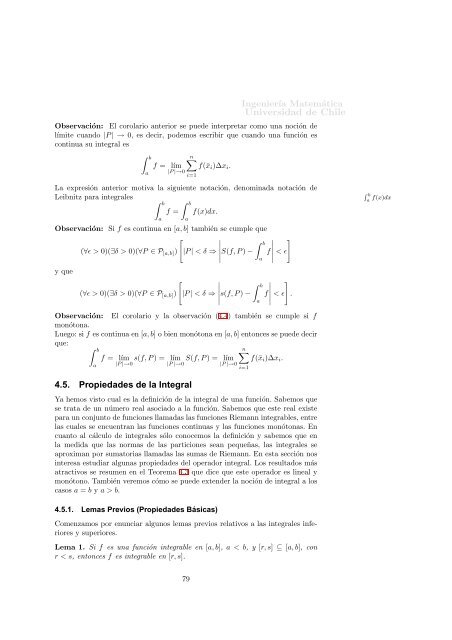4. Integral de Riemann - DIM - Universidad de Chile
4. Integral de Riemann - DIM - Universidad de Chile
4. Integral de Riemann - DIM - Universidad de Chile
You also want an ePaper? Increase the reach of your titles
YUMPU automatically turns print PDFs into web optimized ePapers that Google loves.
Ingeniería Matemática<br />
<strong>Universidad</strong> <strong>de</strong> <strong>Chile</strong><br />
Observación: El corolario anterior se pue<strong>de</strong> interpretar como una noción <strong>de</strong><br />
límite cuando |P | → 0, es <strong>de</strong>cir, po<strong>de</strong>mos escribir que cuando una función es<br />
continua su integral es<br />
b<br />
a<br />
f = lím<br />
|P |→0<br />
i=1<br />
n<br />
f(¯xi)∆xi.<br />
La expresión anterior motiva la siguiente notación, <strong>de</strong>nominada notación <strong>de</strong><br />
Leibnitz para integrales<br />
b<br />
a<br />
f =<br />
b<br />
a<br />
f(x)dx.<br />
Observación: Si f es continua en [a,b] también se cumple que<br />
<br />
<br />
b <br />
<br />
(∀ǫ > 0)(∃δ > 0)(∀P ∈ P [a,b]) |P | < δ ⇒ S(f,P)<br />
− f<br />
< ǫ<br />
<br />
y que<br />
<br />
<br />
<br />
(∀ǫ > 0)(∃δ > 0)(∀P ∈ P [a,b]) |P | < δ ⇒ s(f,P)<br />
−<br />
<br />
a<br />
b<br />
a<br />
<br />
<br />
<br />
f<br />
< ǫ .<br />
<br />
Observación: El corolario y la observación (<strong>4.</strong>4) también se cumple si f<br />
monótona.<br />
Luego: si f es continua en [a,b] o bien monótona en [a,b] entonces se pue<strong>de</strong> <strong>de</strong>cir<br />
que:<br />
b<br />
a<br />
f = lím s(f,P) = lím S(f,P) = lím<br />
|P |→0 |P |→0 |P |→0<br />
<strong>4.</strong>5. Propieda<strong>de</strong>s <strong>de</strong> la <strong>Integral</strong><br />
n<br />
f(¯xi)∆xi.<br />
Ya hemos visto cual es la <strong>de</strong>finición <strong>de</strong> la integral <strong>de</strong> una función. Sabemos que<br />
se trata <strong>de</strong> un número real asociado a la función. Sabemos que este real existe<br />
para un conjunto <strong>de</strong> funciones llamadas las funciones <strong>Riemann</strong> integrables, entre<br />
las cuales se encuentran las funciones continuas y las funciones monótonas. En<br />
cuanto al cálculo <strong>de</strong> integrales sólo conocemos la <strong>de</strong>finición y sabemos que en<br />
la medida que las normas <strong>de</strong> las particiones sean pequeñas, las integrales se<br />
aproximan por sumatorias llamadas las sumas <strong>de</strong> <strong>Riemann</strong>. En esta sección nos<br />
interesa estudiar algunas propieda<strong>de</strong>s <strong>de</strong>l operador integral. Los resultados más<br />
atractivos se resumen en el Teorema <strong>4.</strong>3 que dice que este operador es lineal y<br />
monótono. También veremos cómo se pue<strong>de</strong> exten<strong>de</strong>r la noción <strong>de</strong> integral a los<br />
casos a = b y a > b.<br />
<strong>4.</strong>5.1. Lemas Previos (Propieda<strong>de</strong>s Básicas)<br />
Comenzamos por enunciar algunos lemas previos relativos a las integrales inferiores<br />
y superiores.<br />
Lema 1. Si f es una función integrable en [a,b], a < b, y [r,s] ⊆ [a,b], con<br />
r < s, entonces f es integrable en [r,s].<br />
79<br />
i=1<br />
b<br />
a f(x)dx

















